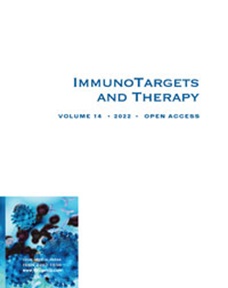Comparative Efficacy and Safety of Neoadjuvant Immunotherapy with Chemotherapy versus Chemotherapy Alone in Non-Small Cell Lung Cancer: A Propensity Score and Inverse Probability Treatment Weighting Analysis
IF 4.4
Q1 IMMUNOLOGY
引用次数: 0
Abstract
Purpose: This study aimed to compare the efficacy and safety of neoadjuvant chemotherapy (NCT) and neoadjuvant immunotherapy combined with chemotherapy (NICT) combined with radical lung cancer resection for the treatment of patients with resectable non-small cell lung cancer (NSCLC). To adjust for confounding factors, we innovatively adopted two matching methods: propensity score (PS) and inverse probability of treatment weighting (IPTW). Patients and Methods: We conducted a retrospective analysis of the clinicopathological features and prognosis of patients with resectable NSCLC treated with NCT or NICT combined with radical lung cancer resection using propensity score matching (PSM) at a ratio of 1:1 and IPTW to balance potential bias. Results: After PSM, 116 pairs of patients who had undergone NCT or NICT were selected for the final analysis. The pathological complete remission (pCR) and major pathological remission (MPR) rates were significantly better in the NICT group than in the NCT group (pCR rate of 44.8% vs 2.6%, P < 0.001; MPR rate of 66.4% vs 20.7%, P < 0.001). No significant difference was seen between the NICT and NCT groups in terms of postoperative complications (12.1% vs 9.5%, P =0.182). Patients in the NICT group had significantly better disease-free survival (DFS) and overall survival(OS) than those in the NCT group ([3-year DFS: 75.2% vs 43.3%, P < 0.001] and [3-year OS: 91.5% vs 58.0%, P < 0.001]). Among all patients, those with postoperative pathology of pCR had better DFS ( P < 0.001) and OS ( P = 0.009). Patients with postoperative pathology of MPR had better DFS ( P < 0.001) and OS ( P < 0.001). The IPTW method yielded similar pathologic and prognostic results. Conclusion: Patients with resectable NSCLC treated with NICT had better pathological responses and prognosis, than those treated with NCT, and the safety profiles of NICT and NCT were similar. Keywords: neoadjuvant immunotherapy, neoadjuvant chemotherapy, non-small cell lung cancer, propensity score matching, inverse probability of treatment weighting, lung cancer resection, immune checkpoint inhibitor非小细胞肺癌新辅助免疫治疗联合化疗与单独化疗的疗效和安全性比较:倾向评分和逆概率治疗加权分析
目的:本研究旨在比较新辅助化疗(NCT)与新辅助免疫治疗联合化疗(NICT)联合根治性肺癌切除术治疗可切除的非小细胞肺癌(NSCLC)患者的疗效和安全性。为了调整混杂因素,我们创新地采用了倾向得分(PS)和处理加权逆概率(IPTW)两种匹配方法。患者和方法:我们采用倾向评分匹配(PSM),以1:1的比例和IPTW来平衡潜在的偏倚,回顾性分析可切除的NSCLC患者接受NCT或NICT联合根治肺癌切除术的临床病理特征和预后。结果:PSM后,116对接受过NCT或NICT的患者被选中进行最终分析。NICT组病理完全缓解(pCR)和主要病理缓解(MPR)率显著优于NCT组(pCR率44.8% vs 2.6%, P < 0.001;MPR率66.4% vs 20.7%, P < 0.001)。NICT组和NCT组在术后并发症方面无显著差异(12.1% vs 9.5%, P =0.182)。NICT组患者的无病生存期(DFS)和总生存期(OS)明显优于NCT组([3年DFS: 75.2% vs 43.3%, P < 0.001]和[3年OS: 91.5% vs 58.0%, P < 0.001])。在所有患者中,术后病理pCR者的DFS (P < 0.001)和OS (P = 0.009)较好。术后病理有MPR的患者有较好的DFS (P < 0.001)和OS (P < 0.001)。IPTW方法获得了类似的病理和预后结果。结论:NICT治疗可切除NSCLC患者的病理反应和预后优于NCT治疗,NICT和NCT的安全性相似。关键词:新辅助免疫治疗,新辅助化疗,非小细胞肺癌,倾向评分匹配,治疗加权逆概率,肺癌切除,免疫检查点抑制剂
本文章由计算机程序翻译,如有差异,请以英文原文为准。
求助全文
约1分钟内获得全文
求助全文
来源期刊

ImmunoTargets and Therapy
IMMUNOLOGY-
CiteScore
16.50
自引率
0.00%
发文量
7
审稿时长
16 weeks
期刊介绍:
Immuno Targets and Therapy is an international, peer-reviewed open access journal focusing on the immunological basis of diseases, potential targets for immune based therapy and treatment protocols employed to improve patient management. Basic immunology and physiology of the immune system in health, and disease will be also covered.In addition, the journal will focus on the impact of management programs and new therapeutic agents and protocols on patient perspectives such as quality of life, adherence and satisfaction.
 求助内容:
求助内容: 应助结果提醒方式:
应助结果提醒方式:


